
The Maimeri Blu colour chart is amazing – such beautiful strong colours. At the moment much contemporary painting has an emphasis on strong, clean and bright colour and I think the Maimeri Blu will deliver this. In practice the paints had wonderful pigment strength, blended easily and dissolved well wet-in-wet without leaving any pigment streaks which can happen with other makes. Cobalt is beautiful mixed with Cadmium Red or Burnt Sienna or Burnt Umber, granulating with the Browns which is so useful for landscapes and old buildings.
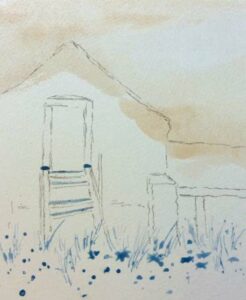 Draw the barn with a 2B pencil, using wobbly lines to describe its old character, then use a sharp twig to apply masking fluid to save some white daisies and grasses in the foreground. Grasses grow randomly, leaning left or right. You can also mask the top of the old broken steps. I tapped the twig against my finger to add a few splatter marks. When the masking fluid is completely dry, using a Size 16 brush mix a wash of Burnt Sienna with lots of water and only a little colour. Also mix a wash of Cobalt Blue with several brush loads of colour in the wash so that it looks like a medium blue and not too pale. Rinse your brush and paint all over the sky with the pale Burnt Sienna, going over the edge of the building and roof.
Draw the barn with a 2B pencil, using wobbly lines to describe its old character, then use a sharp twig to apply masking fluid to save some white daisies and grasses in the foreground. Grasses grow randomly, leaning left or right. You can also mask the top of the old broken steps. I tapped the twig against my finger to add a few splatter marks. When the masking fluid is completely dry, using a Size 16 brush mix a wash of Burnt Sienna with lots of water and only a little colour. Also mix a wash of Cobalt Blue with several brush loads of colour in the wash so that it looks like a medium blue and not too pale. Rinse your brush and paint all over the sky with the pale Burnt Sienna, going over the edge of the building and roof.
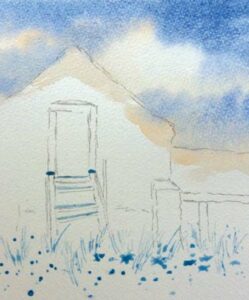 Wait about a minute for the paper to absorb the wash before painting the sky with the Cobalt Blue. The timing will vary depending on temperature. On a warm day you can paint the blue immediately. Use the blue to go around the cloud shapes, leaving them as the pale Burnt Sienna colour. This method gives you a minute or two to paint back into the sky wash with a little more Cobalt at the top if needed.
Wait about a minute for the paper to absorb the wash before painting the sky with the Cobalt Blue. The timing will vary depending on temperature. On a warm day you can paint the blue immediately. Use the blue to go around the cloud shapes, leaving them as the pale Burnt Sienna colour. This method gives you a minute or two to paint back into the sky wash with a little more Cobalt at the top if needed.
 Allow the sky to dry. Using a Size 10 brush start at the top of the building with Burnt Sienna and Cobalt Blue, as the top is quite dark against the sky. The building becomes lighter nearer the ground and more orange. Mix a richer colour now. It needs to be wet enough to flow but to have plenty of paint in the mix. As you start at the top of the building, you can use a 2B pencil or the other end of your paint brush to lift the colour out to make the twigs of the dead ivy. The paint needs to be wet to be able to do this. I added more paint to make a drop of colour standing up on the paper and pulled this out into twigs. Dipping the pencil or brush end into water will lighten the colour, which is useful toward the outside edges.
Allow the sky to dry. Using a Size 10 brush start at the top of the building with Burnt Sienna and Cobalt Blue, as the top is quite dark against the sky. The building becomes lighter nearer the ground and more orange. Mix a richer colour now. It needs to be wet enough to flow but to have plenty of paint in the mix. As you start at the top of the building, you can use a 2B pencil or the other end of your paint brush to lift the colour out to make the twigs of the dead ivy. The paint needs to be wet to be able to do this. I added more paint to make a drop of colour standing up on the paper and pulled this out into twigs. Dipping the pencil or brush end into water will lighten the colour, which is useful toward the outside edges.
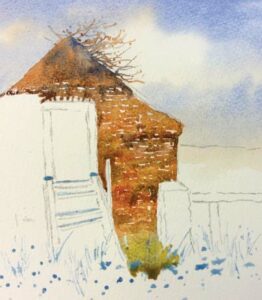 Continue to paint down the wall, adding a mix of Cadmium Red and Yellow to the Burnt Sienna and Cobalt to make some orange bricks. I have painted horizontally to give the effect of old mortar showing in some places and missing in others. You can dot thicker mixes of colour into the bricks while the painting is damp, using Cobalt and Burnt Sienna. Old buildings often have green in their walls or roofs. If you can paint a little green into the grasses as you come to the base of the building, it will help sink it into the ground. Paint the grasses before you paint the barn on the right, as the dark interior needs to go behind the grasses. I used Lemon and Cobalt Blue for the grass near the building.
Continue to paint down the wall, adding a mix of Cadmium Red and Yellow to the Burnt Sienna and Cobalt to make some orange bricks. I have painted horizontally to give the effect of old mortar showing in some places and missing in others. You can dot thicker mixes of colour into the bricks while the painting is damp, using Cobalt and Burnt Sienna. Old buildings often have green in their walls or roofs. If you can paint a little green into the grasses as you come to the base of the building, it will help sink it into the ground. Paint the grasses before you paint the barn on the right, as the dark interior needs to go behind the grasses. I used Lemon and Cobalt Blue for the grass near the building.
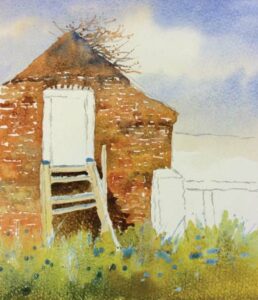 The light is coming from the left. When the walls and grasses are dry, the steps can be painted with pale Burnt Sienna. When dry, the shadow behind the steps and the shadow to the right of the steps can then be painted with Burnt Umber. The shadow on the wall is broken by the texture of the bricks. The grasses can be painted with Lemon and Cobalt near the barn and Cadmium Yellow and Cobalt towards the foreground, varying the colour from left to right.
The light is coming from the left. When the walls and grasses are dry, the steps can be painted with pale Burnt Sienna. When dry, the shadow behind the steps and the shadow to the right of the steps can then be painted with Burnt Umber. The shadow on the wall is broken by the texture of the bricks. The grasses can be painted with Lemon and Cobalt near the barn and Cadmium Yellow and Cobalt towards the foreground, varying the colour from left to right.
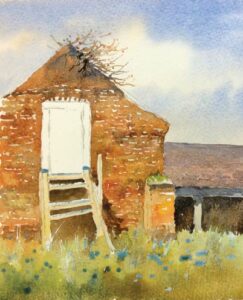 Paint the barn roof with dilute Cadmium Red and Cobalt blue, keeping the paint transparent. Use a little more Cobalt at the top, to show the sky colour reflecting down. When the roof is dry add a few light marks to indicate tiles and paint the timber with dilute Burnt Sienna. Cobalt Blue and Burnt Sienna make a good shadow colour for under the roof and the top of the beam. When this is dry, paint the barn interior using Burnt Umber with a little Cobalt Blue. Interiors like this are usually brown and lighter near the ground.
Paint the barn roof with dilute Cadmium Red and Cobalt blue, keeping the paint transparent. Use a little more Cobalt at the top, to show the sky colour reflecting down. When the roof is dry add a few light marks to indicate tiles and paint the timber with dilute Burnt Sienna. Cobalt Blue and Burnt Sienna make a good shadow colour for under the roof and the top of the beam. When this is dry, paint the barn interior using Burnt Umber with a little Cobalt Blue. Interiors like this are usually brown and lighter near the ground.
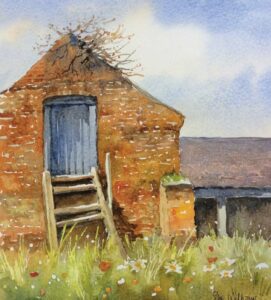 Add a little Burnt Umber underneath and to the right-hand side of the steps and any bricks that look too light can be gently tinted. To paint the door, mix Cobalt with a very little Burnt Sienna. When the door is dry, shadow it on the left side with Cobalt Blue and a little Burnt Umber, and indicate the planks. Some more ivy can be added at the top of the wall if you like. I decided not to paint the distant tree. If you do decide to add the tree, try to keep the paint transparent. You could use Lemon, Cobalt and Burnt Sienna. When all the paint is dry, remove the masking fluid by rubbing with a piece of kitchen towel. Tint grasses with a pale colour such as Lemon and add daisy centres and a few buttercups and poppies. All that is left to do now, is to sign your painting!
Add a little Burnt Umber underneath and to the right-hand side of the steps and any bricks that look too light can be gently tinted. To paint the door, mix Cobalt with a very little Burnt Sienna. When the door is dry, shadow it on the left side with Cobalt Blue and a little Burnt Umber, and indicate the planks. Some more ivy can be added at the top of the wall if you like. I decided not to paint the distant tree. If you do decide to add the tree, try to keep the paint transparent. You could use Lemon, Cobalt and Burnt Sienna. When all the paint is dry, remove the masking fluid by rubbing with a piece of kitchen towel. Tint grasses with a pale colour such as Lemon and add daisy centres and a few buttercups and poppies. All that is left to do now, is to sign your painting!